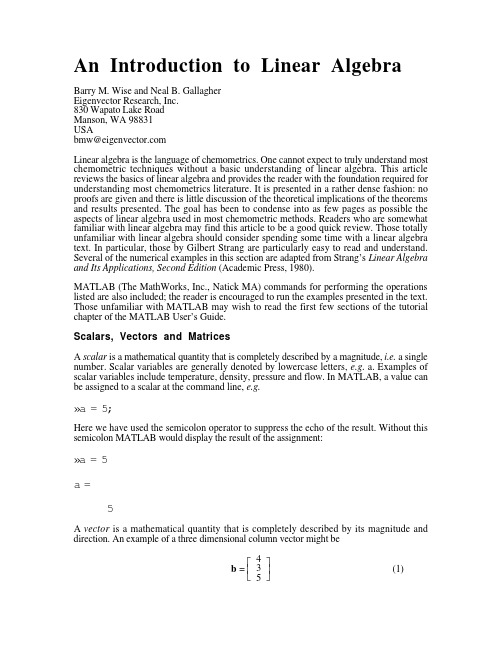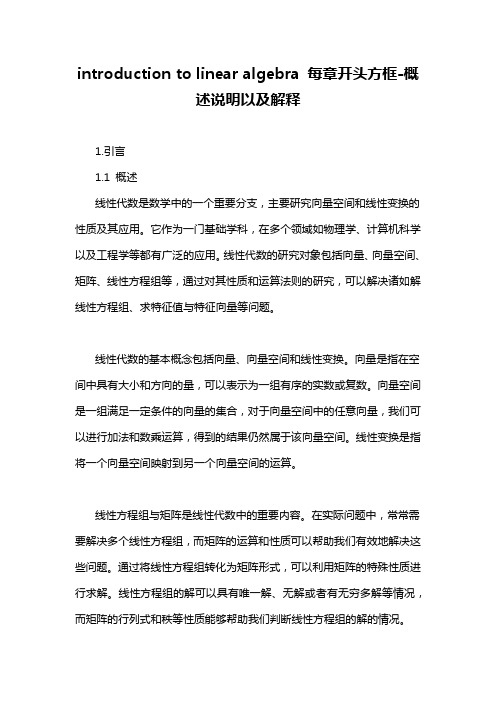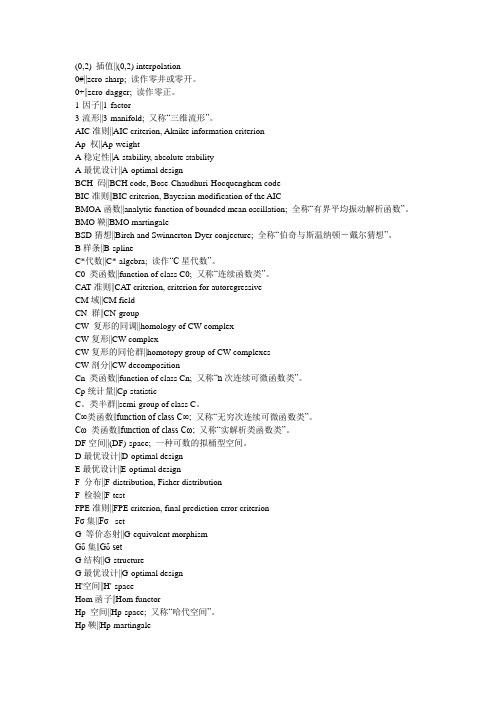Math1001 Linear Algebra tut5_solution
Linear Algebra (chapter1)02

1. Definition 2. Existence of Solutions 3. Computation of Ax 4. Properties of the Matrix-Vector Product Ax
§1.4 The Matrix Equation Ax=b
§1.4 The Matrix Equation Ax=b
2. Existence of Solutions
If the equation Ax=b is consistent, b must satisfy:
This is the equation of a plane through the origin in R3:
§1.4 The Matrix Equation Ax=b
2. Existence of Solutions
Sol. Row reduce the augmented matrix for Ax=b:
∵ ∴
=
≠ 0 (for some choices of b)
ห้องสมุดไป่ตู้
The equation Ax=b is not consistent for every b.
§1.5 Solution Set of Linear Systems
Use vector notation to describe solutions sets of linear system 1. Homogeneous Linear Systems (齐次线性方程组) 2. Parametric Vector Form 3. Solutions of Nonhomogeneous Systems
Introduction to Linear Algebra

»a = 5 a= 5
A vector is a mathematical quantity that is completely described by its magnitude and direction. An example of a three dimensional column vector might be 4 b= 3 5 uld easily assign bT to another variable c, as follows:
»c = b' c= 4 3 5
A matrix is a rectangular array of scalars, or in some instances, algebraic expressions which evaluate to scalars. Matrices are said to be m by n, where m is the number of rows in the matrix and n is the number of columns. A 3 by 4 matrix is shown here 2 A= 7 5 5 3 2 3 2 0 6 1 3 (3)
»a = 5;
Here we have used the semicolon operator to suppress the echo of the result. Without this semicolon MATLAB would display the result of the assignment:
»A(2,4) ans = 1
The transpose operator “flips” a matrix along its diagonal elements, creating a new matrix with the ith row being equal to the jth column of the original matrix, e.g. T A = 2 5 3 6 7 3 2 1 5 2 0 3
牛顿迭代法得到500位小数

要在计算机上计算出500位小数精度的数值是一项极具挑战性的任务,特别是在一般的编程环境下。
Python的内置数据类型和常见的数值计算库(如NumPy)通常只能提供有限的精度。
要获得500位小数精度,你需要使用专门设计用于高精度数值计算的库,比如SymPy和mpmath。
下面是一个更详细的例子,演示如何使用mpmath库计算方程的根,并获得500位小数精度:
from mpmath import mp
# 设置精度为500位小数
mp.dps =500
# 定义方程和初始值
def f(x):
return x**2-2
# 使用牛顿迭代法求解方程根
root = mp.findroot(f, 1.4)
print(root)
这个例子使用了mpmath库,它提供了对高精度数学运算的支持。
通过将精度设置为500位小数(mp.dps = 500),我们可以获得非常高的精度。
然后使用findroot函数来执行牛顿迭代法,寻找方程的数值近似根。
这样就可以获得500位小数精度的结果。
请注意,进行这样高精度的计算会消耗大量的计算资源,并且可能需要较长的计算时间。
在实际应用中,通常只需要有限的精度来获得所需的结果。
Numerical Linear Algebra

letters (and occasionally lower case letters) will denote scalars. RI will denote the set of real
tions to the algorithm, it can be made to work quite well. We understand these algorithmic
transformations most completely in the case of simple algorithms like Cholesky, on simple
LA
Numerical Linear Algebra
Copyright (C) 1991, 1992, 1993, 1994, 1995 by the Computational Science Education Project
This electronic book is copyrighted, and protected by the copyright laws of the United States. This (and all associated documents in the system) must contain the above copyright notice. If this electronic book is used anywhere other than the project's original system, CSEP must be noti ed in writing (email is acceptable) and the copyright notice must remain intact.
introduction to linear algebra 每章开头方框-概述说明以及解释

introduction to linear algebra 每章开头方框-概述说明以及解释1.引言1.1 概述线性代数是数学中的一个重要分支,主要研究向量空间和线性变换的性质及其应用。
它作为一门基础学科,在多个领域如物理学、计算机科学以及工程学等都有广泛的应用。
线性代数的研究对象包括向量、向量空间、矩阵、线性方程组等,通过对其性质和运算法则的研究,可以解决诸如解线性方程组、求特征值与特征向量等问题。
线性代数的基本概念包括向量、向量空间和线性变换。
向量是指在空间中具有大小和方向的量,可以表示为一组有序的实数或复数。
向量空间是一组满足一定条件的向量的集合,对于向量空间中的任意向量,我们可以进行加法和数乘运算,得到的结果仍然属于该向量空间。
线性变换是指将一个向量空间映射到另一个向量空间的运算。
线性方程组与矩阵是线性代数中的重要内容。
在实际问题中,常常需要解决多个线性方程组,而矩阵的运算和性质可以帮助我们有效地解决这些问题。
通过将线性方程组转化为矩阵形式,可以利用矩阵的特殊性质进行求解。
线性方程组的解可以具有唯一解、无解或者有无穷多解等情况,而矩阵的行列式和秩等性质能够帮助我们判断线性方程组的解的情况。
向量空间与线性变换是线性代数的核心内容。
向量空间的性质研究可以帮助我们理解向量的运算和性质,以及解释向量空间的几何意义。
线性变换是一种将一个向量空间映射到另一个向量空间的运算,通过线性变换可以将复杂的向量运算问题转化为简单的矩阵运算问题。
在线性变换中,我们需要关注其核、像以及变换的特征等性质,这些性质可以帮助我们理解线性变换的本质和作用。
综上所述,本章节将逐步介绍线性代数的基本概念、线性方程组与矩阵、向量空间与线性变换的相关内容。
通过深入学习和理解这些内容,我们能够掌握线性代数的基本原理和应用,为进一步研究更高级的线性代数问题打下坚实的基础。
1.2文章结构在文章结构部分,我们将介绍本文的组织结构和各章节的内容概述。
代数英语

(0,2) 插值||(0,2) interpolation0#||zero-sharp; 读作零井或零开。
0+||zero-dagger; 读作零正。
1-因子||1-factor3-流形||3-manifold; 又称“三维流形”。
AIC准则||AIC criterion, Akaike information criterionAp 权||Ap-weightA稳定性||A-stability, absolute stabilityA最优设计||A-optimal designBCH 码||BCH code, Bose-Chaudhuri-Hocquenghem codeBIC准则||BIC criterion, Bayesian modification of the AICBMOA函数||analytic function of bounded mean oscillation; 全称“有界平均振动解析函数”。
BMO鞅||BMO martingaleBSD猜想||Birch and Swinnerton-Dyer conjecture; 全称“伯奇与斯温纳顿-戴尔猜想”。
B样条||B-splineC*代数||C*-algebra; 读作“C星代数”。
C0 类函数||function of class C0; 又称“连续函数类”。
CA T准则||CAT criterion, criterion for autoregressiveCM域||CM fieldCN 群||CN-groupCW 复形的同调||homology of CW complexCW复形||CW complexCW复形的同伦群||homotopy group of CW complexesCW剖分||CW decompositionCn 类函数||function of class Cn; 又称“n次连续可微函数类”。
Cp统计量||Cp-statisticC。
introduction to linear algebra 5th edition 中译 -回复

introduction to linear algebra 5th edition 中译-回复"Introduction to Linear Algebra 5th Edition 中译"主题文章第一步:介绍《Linear Algebra 5th Edition 中译》及其重要性《Linear Algebra 5th Edition 中译》是一本介绍线性代数的教材。
线性代数是数学中的一个重要分支,涉及向量空间、线性方程组、特征值和特征向量等概念。
这些概念在数学、物理学、计算机科学、经济学和工程学等领域都有广泛应用。
本书旨在为读者提供系统、全面且易于理解的线性代数基础知识,帮助读者建立起与今后的学习和研究相结合的数学基础。
此次中文翻译对于那些使用中文学习的学生和研究者,特别是那些需要掌握线性代数以支持他们的学术和职业发展的人来说,具有重要意义。
第二步:介绍线性代数的基本概念和应用线性代数是一门研究线性映射和向量空间的学科。
它涉及将线性方程组转化为矩阵,解决线性方程组的问题,以及在现实世界中描述和解决各种问题的能力。
线性代数也是许多其他学科的基础,例如机器学习、图像处理和优化问题。
通过学习线性代数,读者可以理解向量、矩阵、空间、线性变换、特征值和特征向量等概念,培养抽象思维、推理能力和解决实际问题的能力。
第三步:介绍《Linear Algebra 5th Edition》的特点和优势《Linear Algebra 5th Edition 中译》具有以下特点和优势:1.系统全面:本书从基本概念开始介绍线性代数,逐步展开。
读者可以完整地掌握线性代数的核心概念和理论。
2.易于理解:作者使用简洁明了的语言和示例,帮助读者深入理解抽象的线性代数概念。
此外,作者还提供了大量的习题和解答,以巩固和测试理解。
3.应用广泛:本书覆盖了线性代数的许多应用领域,如物理学、计算机科学和经济学。
读者可以从实际问题出发,将所学的线性代数知识应用到实际中。
python解偏微分方程

python解偏微分方程
Python是一种强大的编程语言,可以用于解决各种数学问题,包括解偏微分方程。
偏微分方程是描述自然现象和物理过程的基本方程之一,因此对于科学家和工程师来说,解决偏微分方程问题是非常重要的。
Python提供了许多工具和库来解决偏微分方程。
其中最常用的库是NumPy和SciPy。
NumPy是一个用于数值计算的库,可以用于创建和操作大型多维数组。
SciPy是一个科学计算库,包含许多解偏微分方程的算法和函数。
在Python中解偏微分方程的方法包括有限差分法、有限元法、谱方法等。
有限差分法是一种数值方法,通过将偏微分方程离散化为有限差分方程来求解。
有限元法是一种数值方法,通过将偏微分方程离散化为一个有限元模型来求解。
谱方法是一种数值方法,将解表示为一系列基函数的线性组合。
Python的优势在于其简单易用性和可读性。
Python代码易于编写、调试和维护,同时也可以快速处理大量数据。
Python还提供了许多可视化工具,可以用于可视化偏微分方程的解和模拟结果。
在Python中解偏微分方程需要一定的数学知识和编程经验。
但随着Python的不断发展和改进,使用Python解决偏微分方程的难度也不断降低。
因此,Python成为了解决偏微分方程问题的有力工具之一。
- 1 -。
- 1、下载文档前请自行甄别文档内容的完整性,平台不提供额外的编辑、内容补充、找答案等附加服务。
- 2、"仅部分预览"的文档,不可在线预览部分如存在完整性等问题,可反馈申请退款(可完整预览的文档不适用该条件!)。
- 3、如文档侵犯您的权益,请联系客服反馈,我们会尽快为您处理(人工客服工作时间:9:00-18:30)。
T HE U NIVERSITY OF S YDNEYS CHOOL OF M ATHEMATICS AND S TATISTICSSolutions to Tutorial5Web Page:.au/u/UG/SS/SS1001/Preparatory questions1.For each function,find the indicated derivative(ordinary or partial).Recall that to computef x(x,y),regard y as a constant and differentiate f(x,y)with respect to x.Similarly,to computef y(x,y)regard x as a constant and differentiate f(x,y)with respect to y.(a)f(x)=3x2−16;d f∂x and∂fdy Solution:f′(y)=15e3y(d)f(x,y)=xe3y;∂f∂ySolution:f x(x,y)=e3y,f y(x,y)=3xe3y (e)f(x)=4ln x;d fx(f)f(x,y)=y ln x;∂f∂ySolution:f x(x,y)=yx2+4;d f(x2+4)2=8−2x2x2+y2;∂f∂ySolution:By the quotient rule,f x(x,y)=y(y2−x2)(x2+y2)2. Copyright c 2011The University of Sydney12.Let f(x,y)=x3+x2y3−2y2.Calculate the partial derivatives f x(x,y)and f y(x,y)andfind thevalue of each derivative at the point(1,2).Solution:By direct calculation:f x(x,y)=3x2+2xy3f x(1,2)=19,f y(x,y)=3x2y2−4y f y(1,2)=4.Questions to do in class3.Let f(x,y)=2x−3y+2.(a)Find the equation of the tangent plane to the surface z=f(x,y)at the point(x,y)=(3,1).Solution:Since f(x,y)=2x−3y+2,we have f x(x,y)=2and f y(x,y)=−3.In par-ticular,f x(3,1)=2and f y(3,1)=−3.Therefore,the equation of the tangent plane toz=f(x,y)when(x,y)=(3,1)isz−5=2(x−3)−3(y−1),which can be rearranged into either of the equivalent forms,z=2x−3y+2,2x−3y−z=−2.(b)Can you explain the relationship between the tangent plane and the surface z=f(x,y)?Solution:The tangent plane is exactly the original surface z=f(x,y).This is what weshould expect because,just as the tangent line to a line at any point is the same line,thetangent plane to a plane at any point is the same plane.4.Find thefirst-order partial derivatives f x(x,y)and f y(x,y)of the following functions:(a)f(x,y)=√2√x+√2√2√∂x =2x,∂z∂x (2,1)=4,∂zTherefore,the equation of tangent plane isz−8=4(x−2)+8(y−1),which can be rearranged toz=4(x+2y−2).6.Recall the“informal”definition of the limit of a function f(x)as x approaches the number c.We say lim x→c f(x)=ℓif we can make f(x)as close as we like toℓfor all x sufficientlyclose to(but not equal to)c.For each of the functions given by the formulas below,sketch the graph and decide whether or not the function has a limit as x→1.(Note:Only an intuitive idea of the limit of a function is required here.Limits and limit laws will be discussed in more detail later in the course.) (a)f(x)= 1if x<1,−x if x>1.Solution:If there is a limit,it must be a single numberℓwith the property that values of f(x)can be made as close as we like toℓby choosing x sufficiently close to1.The graph shows that when x is less than1,f(x)=1and so if the limit exists it should be1.However,when x is arbitrarily close to1 but greater than1,the values of f(x)are approaching−1and so the limit,if it exists,should be −1.Thus it is impossible to have a singleℓwhich is compatible with the informal definition;the function does not have a limit as x→1.(b)f(x)= x if x<1,2−x if x>1.Solution:For this function the limit exists and is equal to1.We can make f(x)as close to1as we like by choosing x sufficiently close to1(but not equal to1).(Although not required for the answer,the3following sample calculations may help you to understand the process.If we want,for example, f(x)to be within0.01of1(i.e.0.99<f(x)<1.01)then we must choose x to be no further away from1than0.01units,i.e.0.99<x<1or1<x<1.01.If we want f(x)to be within0.001of1 (i.e.0.999<f(x)<1.001)then we must choose x to be no further away from1than0.001units, i.e.0.999<x<1or1<x<1.001.)(c)f(x)= x2−1if x<1,√∂V ∂V∂P=−1.Solution:Since P=kT∂V=−kTP,we have∂VP.SinceT=PV∂P=V∂V∂V∂P= −kT P V V P=−1.Questions for further practice8.Find the ordinary derivatives of the following functions.(a)f(x)=sin xe2x =cos x−sin x(b)g(y)=tan(y2+cos y)Solution:The chain rule gives g′(y)=(2y−sin y)sec2(y2+cos y) (c)h(w)=ln(w+sin(w3+4))Solution:The chain rule gives h′(w)=1+3w2cos(w3+4)t2+1Solution:The quotient rule givesF′(t)=(t2+1)(3t2+10t)−(t3+5t2−1)(2t)(t2+1)2(e)G(u)=21+cos vSolution:The quotient rule gives H′(v)=(1+cos v)(2tan v sec2v)+tan2v sin v∂x ,∂f2x+3y;f y(2,4)Solution:f y(x,y)=32x+3y,f y(2,4)=34+12=3∂y(1,0)Solution:∂f∂y(1,0)=f y(1,0)=−1+3=2.(d)z=x√√∂x,∂z∂x=√2x−3/2 =√2x3/2,∂z2y−1/2 −1x=x y−1x.(e)f(u,v)=tan−1 u∂u,∂f1+(u/v)21u2+v2,f v(u,v)=1v2 =−u10.Find the twofirst-order partial derivatives of the following functions:(a)w=cos u sin vSolution:∂w∂v=cos u cos v.(b)V=πr2aSolution:∂V∂a=πr2.11.Find the equation of the tangent plane to the given surface at the specified point.(a)z=5+(x−1)2+(y+2)2;(2,0,10).Solution:∂z∂y=2(y+2)=4, when(x,y)=(2,0).Therefore,the equation of the tangent plane isz−10=2(x−2)+4(y−0),which can be rearranged toz=2(x+2y+3).(b)z=sin(x+y);(1,−1,0).Solution:We have∂z∂y=cos(x+y)=cos0=1,when(x,y)=(1,−1).Therefore,the equation of the tangent plane isz−0=1(x−1)+1(y+1),which can be rearranged toz=x+y.(c)z=ln(2x+y);(−1,3,0).Solution:We have∂z2x+y =2,∂z2x+y=1,when(x,y)=(−1,3).Therefore,the equation of the tangent plane isz−0=2(x+1)+1(y−3),which can be rearranged toz=2x+y−1.12.(Harder)Show that the ellipsoid3x2+2y2+z2=9and the sphere x2+y2+z2−8x−6y−8z+24=0are tangential to each other at(1,1,2).That is,show that these two surfaces have a common tangent plane at the point(1,1,2).Solution:The ellipsoid is centred at the origin and has semiaxes a=√2and c=3.The sphere has centre(4,3,4)and radius r=√9−3x2−2y2.6Now,rewrite the given equation of the sphere as(x −4)2+(y −3)2+(z −4)2=17.We then see that the point (1,1,2)lies on the lower half of the sphere (since the sphere is centred at (4,3,4).Solving for z and taking the negative square root (why?)gives the equation,z =k (x ,y )=4−2,h y =−2y 9−3x 2−2y 2,h y (1,1)=−1.Hence,the equation of the tangent plane is z −2=−(3/2)(x −1)−(y −1),which rearranges to3x +2y +2z =9.Similarly,the equation of the tangent plane to the surface z =k (x ,y )at (1,1)isz −2=k x (1,1)(x −1)+k y (1,1)(y −1).The required derivatives arek x =x −417−(x −4)2−(y −3)2,k x (1,1)=−3。
